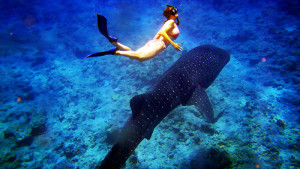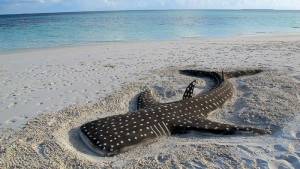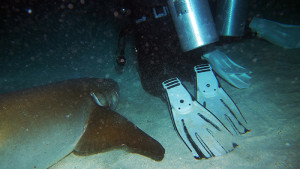The Roundup
Following on from his article in last month’s Outdoor UAE, Alaa Ali reports on his third, fourth, fifth and sixth days of diving in the Maldives. Read on to find out more about the types of dives enjoyed by Alaa, and the varying locations that he visited as part of his liveaboard experience.
Day 3
Early Morning Hammerhead Dive – Felidhoo Atoll – (Blue Ocean Dive)
The FotteyoKandu dive site is not only famous for the day dive but also for a 6:00 a.m. Hammerhead dive. This dive is performed very differently from the day dive as divers spend most of their time in the blue water. During the early morning hours scalloped hammerheads rise to shallower depths and divers get to take a glimpse of them. Unfortunately we were unlucky!
Golden Wall – Felidhoo Atoll – (Channel Dive)
Named for the beautiful blanket of yellow soft coral that covers it, the Golden Wall is located adjacent to a channel that acts as a busy expressway for sharks and stingrays, eagle rays, schooling tuna and trevally, and barracuda. With overhangs where turtles and sharks sometimes nap, and where glassfish and colourful schools of anthias and other reef fish can normally be found, the site is also home to moray eels, lobsters, crabs, and others. Beginning at ten metres and featuring a maximum depth of 35 metres, the site is suitable for all divers.
Devana Kandu – Felidhoo Atoll – (Channel Dive)
This has been declared a Marine Protected Area, and is certainly one of the most exciting drift dives of Felidhoo Atoll. In the outer reef there are caves that fall vertically from 30 metres into the depths below. In the middle of the northern passage is a long, narrow reef which rises slightly up to 15 meters from the sandy floor of about 18 meters. Divers can go along the channel length from the north to discover south passages that are merged, featuring a wide range of healthy corals. A magnificent display of corals stretches for every 500 meters of channel width to a depth of about 15 meters, which is highly unlike any other diving channel.
Alimatha- Felidhoo Atoll – (Reef Night Dive)
Alimatha is five-star experience! One of the Maldives’ most famous dive sites, it has rightfully earned its reputation. Here is the best advice. Jump in the water about 20-30 minutes before sunset, NOT when it’s dark.
Pretty much as soon as you are in the water, you are overwhelmed by the action. There are plenty of nurse sharks that come whizzing past you, stingrays that rub up to you like cats or unceremoniously nudge you out of the way, and giant trevally that are too busy going about their business to care about mere divers.
My advice would be, to stick with your group, and not to move around too much — pick a spot with no other groups nearby and get comfortable. Obviously you will need a torch, and if you are shooting underwater it gets really tricky. If you are shooting stills you will need a focus light, and you’ll need at least one powerful strobe if you are shooting a video. The best thing is that you can just sit down and let the scenes come to you, so just get comfortable, select your settings and shoot away!
Day 4
Kudara Thila – South Ari Atoll – (Reef Dive)
This is a really beautiful dive. We started by going through an arch covered in coral. There were coral and reef fish of all colours on top and lots of snappers, fusilier and anthias. On the top of the thilawas a large turtle, moray eels, angelfish, coral groupers, soldierfish, nudibranchs, triggerfish and various puffers. There are also large overhangs with beautiful coral in the roof. The reef top is at 14 metres with sharp drop-offs to 20 and 25 metres on most sides. There is a small canyon on the north side and a large, long cave at 20 metres on the eastern side. When the current is not too strong, divers can swim around this 80 metres long thila without too much difficulty. On the deeper, more gentle slopes on the northern side are large sea fans. Swimming around the fan slopes there are a number of grey and white-tip reef sharks.

OLYMPUS DIGITAL CAMERA
Kudhi Maa – South Ari Atoll – (Wreck Dive)
KudhiMaa Wreck is a medium sized steel wreck lying very close to the Machchafushi house reef. The wreck is a Japanese cargo ship that was purposely sunk in 1998 to provide divers visiting the South Ari Atoll with a wreck. Measuring 52 metres wide, around the shipwreck you can find a school of batfish, some puffer fish, box fish, large lion fish and two basking nurse sharks who are always positioned under the wreck! One interesting feature of the wreck is the competition for space that has sprung up on the surface itself. Algae, sponges, sea squirts and corals are all fighting for that valuable piece of metal from which to start their growth. Depth is 12m descending to 30m.
Day 5
Five Rocks – South Ari Atoll – (Pinnacle Dive)
This site contains five huge pinnacles at 25 metres deep. There was a strong current and visibility wasn’t great. It is full of channels, overhangs, and so many fish, including about six sharks, two napoleons, leaf fish, oriental sweet lips and moray eels. What I have noticed here is that the coral reef is healthy and very colourful! This remote site is made up of five underwater rocks forming a pinnacle with a flat top at about 15 metres. A GPS was used to locate the site, which is washed by currents. The marine life and corals are truly spectacular.

Sun Island Beyru – South Ari Atoll – (Reef Dive)
Whale shark searching began at 9:00 a.m. We spotted the first whale shark near Sun Island Beyru and snorkelled for almost 20 minutes before the whale shark faded into the blue! The second encounter was at the outer reef of Sun Island Beyru while diving, and once again the whale shark swam with us for a few minutes. I noticed for the first time the swinging current effect, which was nice but meant thatyou had to keep an eye on yourself in case you hit or damaged the coral reef whilst swinging.
Dhigga Thila – South Ari Atoll – (Reef Dive)
One of the few thilas in the Ari Atoll displayed magnificent coral growth; this was a great site for reef sharks, with large gorgonian fan corals and large overhangs worth exploring. The table corals on top of the thila are also worth checking out. For me this was one of the best dives in the Maldives, after finishing three dives on this day! The crew had prepared a treat for all divers, taking us to an abandoned island to enjoy an amazing BBQ dinner – a real Pirates of the Caribbean experience!
Day 6
Panettone – South Ari Atoll – (Reef Dive)
The minute we jumped into the water, there was a 3.5 metre manta ray waiting for us! It was hovering over a rock, allowing cleaning fishes to do their job. The encounter was pretty close. Behind us a white tip reef shark and eagle ray were swimming. The water current got stronger and it was swinging so we had to hold onto the rocks.
Dhega Thila – South Ari Atoll – (Reef Dive)
This is a very interesting formation, with a wall of sea fans on the outside of the main peak, and some pinnacles on the western side. There is a tunnel to swim through cutting the reef where yellow sweepers stay. At the north side there are another two pinnacles, with a narrow canyon between them. The dive can be very deep and the currents treacherous. This was the worst dive on this trip due to very strong currents which I couldn’t fight and I actually ended the dive after 15 minutes.
Moofushi Kanu – South Ari Atoll – (Reef Dive)
A reef around 2km long, with caves and overhangs breathing with life. Here you can admire the sea fans, whip corals, and its marine life, like sting rays, manta rays, napoleon wrasse and sharks.

Conclusion
A liveaboard is by far the best way to cover a large area and see the best dive sites the selected atolls have to offer. All of the sites were good, but some were better than others. Strong water currents were an obstacle for me at some dive sites, but I would certainly go back for more!
Words by: Alaa Ali
Photos by: Guido Peeters, Krystal Leong and Laetitia Zimmermann





